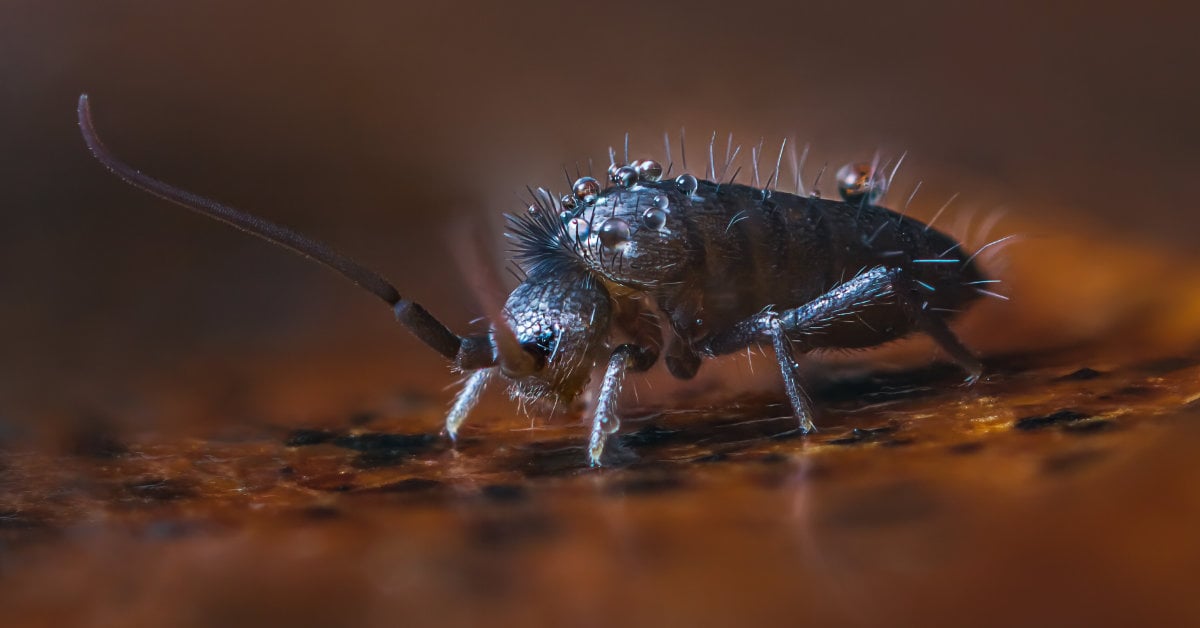How to Get Rid of Springtails

Viking Pest technicians have seen an unusual increase in springtail activity this summer. But what are springtails? Why are their populations increasing so rapidly? Why does it matter? Learn the answers to these questions and more in this blog.
What are Springtails?
Resembling the common flea in size and shape, springtails are tiny insects around 1/8 inch in length and brown or brownish-white in color. When congregating on decaying leaves, woods, and plants, springtails are difficult to see because of their small size and brown bodies.
The most easily identifiable characteristic of a springtail is its incredible ability to spring quickly from one spot to another. Springtails jump like grasshoppers, only instead of their legs, springtails launch themselves with a forked appendage attached to their abdomens, It is this distinctive jumping capability that gives springtails their names. Although most species of springtails have this appendage, some larger springtail species that live deep in the ground do not.
Although springtails play a vital role in ecosystems by decomposing organic material which is used by plants for food, they can occasionally be harmful to plant roots. They can absorb nutrients the plants derive from the soil, causing leaves to yellow or wilt. Once the springtails are removed, the plants can start to recover.
Springtail infestations in residential and commercial buildings are not harmful to humans or pets. However, they can and will jump on people and pets in an infested building and could eventually infest cupboards and pantries containing food.
Why is Indoor Springtail Control Difficult?
Damp, dark places that encourage mold growth represent the perfect places for springtails to thrive. Springtail infestations usually begin in moist basements, behind appliances, underneath bathroom and kitchen sinks, or anywhere there may be an undetected water leak. Springtails will also invade homes seeking moisture when the environment outside is unusually dry and mold growth is nonexistent. Moreover, springtails are amazingly prolific. There's an old saying that if you spot one cockroach, you've likely got 500 more cockroaches hiding in your house or businesses. You can apply that same saying to springtails!
How to Get Rid of Springtails with Over-the-Counter Products
Buildings infested with springtails almost always have one or more water leaks that are creating a damp, moldy environment preferred by springtails. The following DIY tips for getting rid of springtails may work only if the source of the water leak is found and repaired.
- Spray oxygenated bleach directly on large populations of springtails. Bleach will immediately kill springtails.
- Spray cider vinegar on springtails. This type of vinegar is highly acidic and will quickly burn and kill springtails.
- Lavender, eucalyptus, and tea tree oil repels springtails but does not kill them. Once the source of the moisture in a building has been discovered and fixed, these scented oils may help drive them away permanently. Mix a combination of all three scented oils and spray them where springtails are most active.
Professional Springtail Solutions
While DIY methods may help deal with immediate springtail problems, resolving the overall infestation may take more professional knowhow.
When repairing water leaks, eliminating dampness, and using home remedies fail to rid your home, business, and life of springtails, call the professionals at Viking Pest Control serving Pennsylvania, New Jersey, the Eastern Shore of Maryland, and Delaware home and business owners. We will eliminate your springtail infestation using sustainable treatments that are EPA approved for use in residential and commercial buildings. To schedule a free spingtail quote call 800-618-2847 or request a free estimate from our website.











